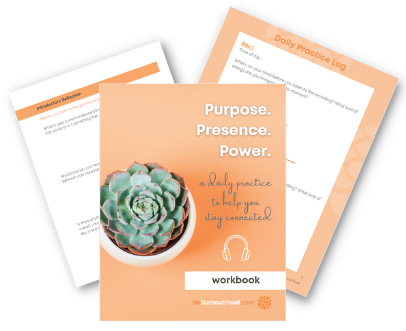Burnout Proof's Framework for Downshifting and Recharging
2021.08.01
At Burnout Proof, our approach to downshifting and recharging centers on four tenets:
- It takes practice to downshift, relax, and recover.
- You have your own unique signs of depletion and can learn to triage and treat your depletion.
- It is helpful to think in terms of transitions as opposed to static states of being.
- Stress management is a tool to actively use during your day.
It Takes Practice
We spend so much of our waking hours in a work-related context. Getting up and getting ready for work. Working during work hours. Eating some of your meals in a work context. Thinking about work after hours. And for many, a commute to/from work. And if you travel for work, you’re even sleeping in a work context, eating more meals within it, connecting with loved ones within it, etc.
It’s normal to need to (re)learn to downshift out of work mode. Because work is a dominant feature of our lives, we need to intentionally adopt practices that will help sustain us over the long run.
The unconscious belief seems to be that if you want to relax, you’ll know how to do it. I’d say it’s common to know how to unwind in theory, but in practice it is easier said than done.
And when it comes to proactively recharging your energy, many people have never even stopped to consider what truly fills them up. They’ll use PTO to do life admin stuff, for social events and family obligations, and haphazard vacationing – if they use them at all. Proactively recharging is its own daily and lifelong practice.
You absolutely can (re)learn how to downshift, relax, and recharge. Know that it takes introspection, experimentation, practice, and iteration over the course of your worklife.
Recognize and Treat Your Energy Depletion
Each of us experiences the effects of a demanding worklife differently. But the fact that from time to time (or daily if I’m being honest) we feel depleted is universal.
Recognizing your own signs of depletion and examining the underlying causes is a key element in your ability to downshift, relax, and recharge.
It’s important to figure out what activities you can to do triage a situation on the fly versus what to do if you have a little more time - as well as what to do that makes you feel fully recovered and recharged.
Transitions are Fundamental
The essence of downshifting is that you are operating in a “high gear” while in work mode, one that is stress inducing and makes you feel keyed up, and you’ll intentionally transition to a more relaxed mode via a series of activities and practices.
Most of the time you don’t need to go from full work mode to full relaxation. It is often useful to back off a bit though and continue at a more sustainable pace or level of mental exertion. Or you’d like to have work off your mind so you can enjoy the evening or weekend.
A variety of transition timeframes will come into play: recovering in the moment from something stressful that just happened, context switching between meetings or deep work, and daily, weekend, and vacation transitions out of work mode.
Learn to view downshifting, relaxation, and recovery as feelings on a continuum that you transition between. Your rate of transition will vary and that is normal.
Active Stress Management
Stress is a part of worklife (duh). If you want to excel professionally without burning out, you need a proactive stress management strategy overall and to learn to actively manage your stress from moment to moment. Stress management isn’t something you do only after work or on the weekends.
It takes time and energy to actively manage your stress. Accept that. Stress management doesn’t magically make you feel relaxed. In fact, it is some of the reason you feel depleted – you are expending energy as you navigate your stress response.
